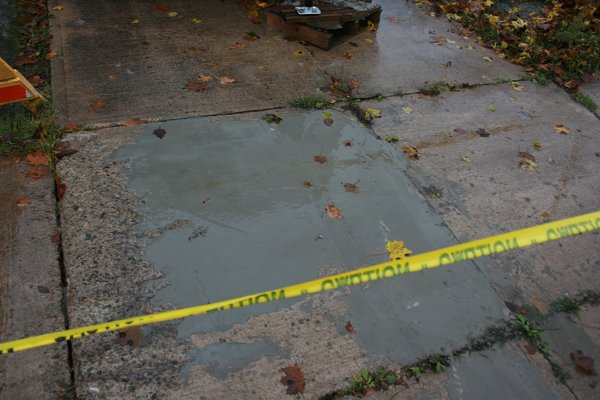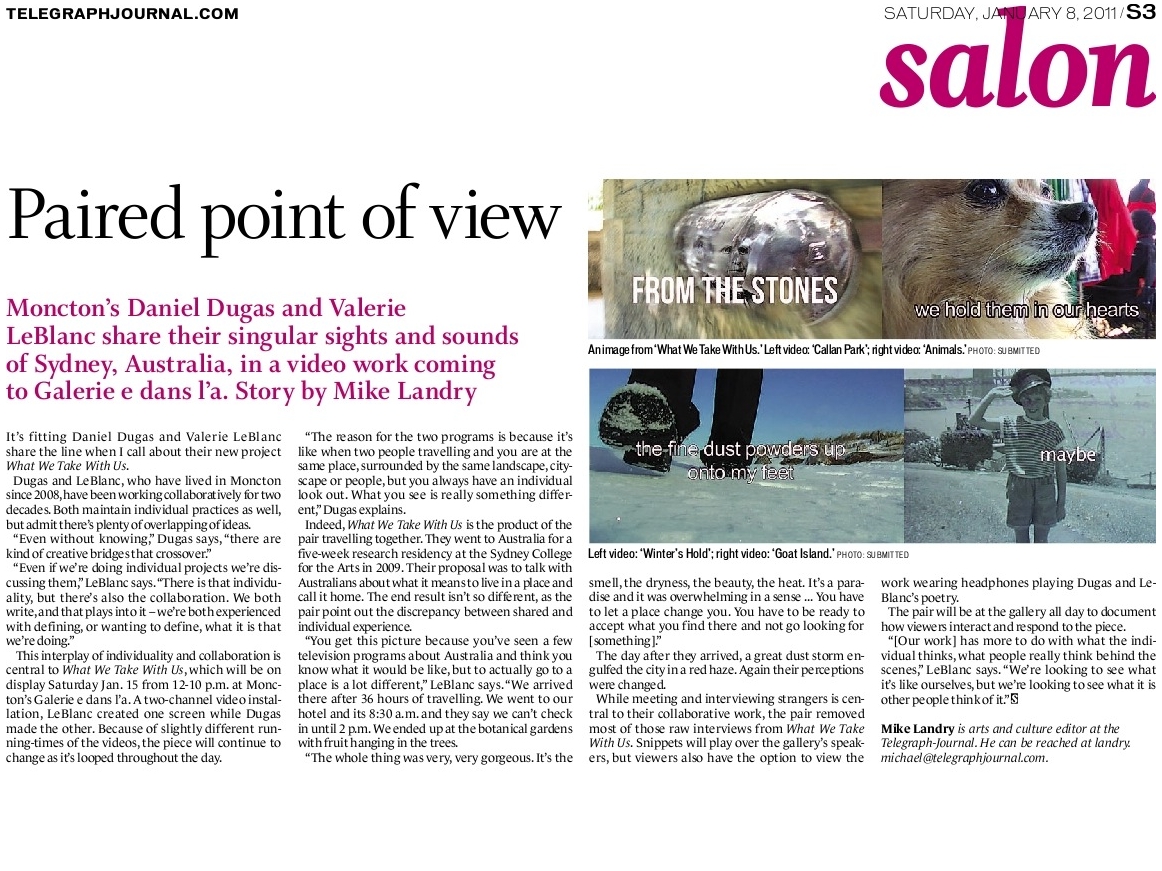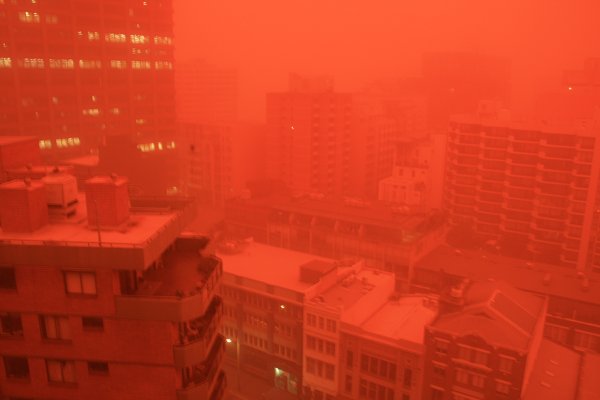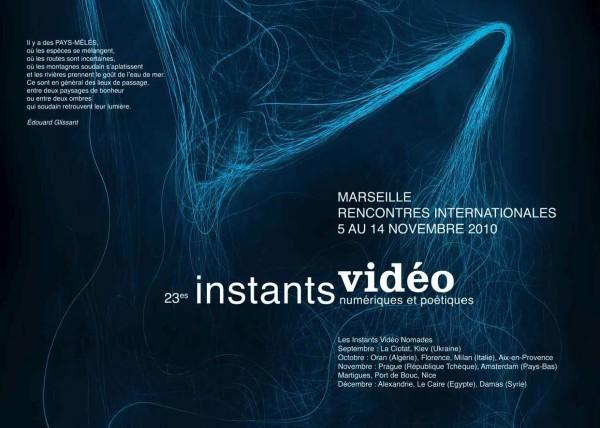Corps flottants (2011)
Les corps flottants ou, plus anciennement, mouches volantes se définissent comme des formes de filaments, plus ou moins opaques, qui apparaissent dans le champ visuel. Dans ce vidéo, les notes de musique écrites par Jean-Philippe Rameau se mettent à danser follement sur les couches superposées des partitions.
La bande sonore est une adaptation de Gavotte et variations (6). Le fichier son est disponible selon les termes de la licence Creative Commons Paternité – Partage des conditions initiales à l’identique 2.0 générique.
fr.wikipedia.org/wiki/Fichier:Jean-Philippe_Rameau_-_Gavotte_and_Variations_(6).ogg
Deux articles récents (2011)
Deux articles récents à propos de notre exposition What We Take With Us – Ce qu’on emporte avec nous, qui aura lieu samedi le 15 janvier à la Galerie E dans l’A.
Une réflexion médiatique sur l’essence d’un lieu
12 janvier, 2011
Nadia Gaudreau B4 L’Étoile
Les artistes Daniel Dugas et Valerie LeBlanc ont commencé leur réflexion pour le projet «What We Take With Us» il y a de cela déjà plus de trois ans. À la suite d’un projet de résidence au Sydney College For The Arts en Australie, le couple a pu se pencher sur la notion de l’essence d’un lieu, de ce qu’on y retrouve et de ce qu’on a laissé derrière soi pour y être. Le résultat : deux séries de courts vidéos artistiques qui seront montrés simultanément, accompagnés de textes poétiques en lien avec les images. Ils présenteront le fruit de leur démarche le 15 janvier à la galerie L’e dans l’a à Moncton pour une seule journée seulement.
Valerie LeBlanc et Daniel Dugas, qui collaborent depuis plus de 20 ans, sont toujours à l’affut de l’art, car, ne sait-on jamais, on peut le retrouver dans des choses aussi banales qu’un mur de béton, à travers une fenêtre ou simplement en regardant la mer. «C’est la beauté de l’art. Il se renouvelle et est partout», dit Daniel Dugas.
Le duo a commencé à se questionner en 2007 sur la notion du nomadisme, de la mémoire personnelle et collective et de l’essence des lieux qu’ils visitaient.
Puis, en 2009, ils sont acceptés pour effectuer une résidence d’artiste en Australie, une expérience qui leur aura donné du temps pour réfléchir.
«D’habitude, on est toujours pressés dans nos projets, on va vite, vite, vite. Là, on a enfin eu du temps et de l’espace pour réfléchir», souligne Daniel Dugas, lors d’une entrevue avec L’Étoile dans sa maison de Moncton.
Les deux artistes multidisciplinaires ont donc réalisé des vidéos de 12 et 13 minutes. Chacun de ceux-ci est composé de six ou sept courtes séquences. Chacune de ces séquences est accompagnée d’un texte qui peut être présenté en anglais ou en français. Puisque les deux vidéos ne sont pas de la même longueur, en les présentant simultanément et en boucle, le résultat de l’oeuvre sera différent tout au long de la journée.
Les spectateurs vont aussi pouvoir choisir entre la bande sonore du vidéo de Daniel ou de Valerie, permettant encore ici une expérience différente. «On a filmé les vidéos ensemble, mais on a choisi de traiter différentes choses, car ce qui peut frapper l’un peut laisser l’autre indifférent. Les arts médiatiques invitent à la collaboration. Pour ce projet, nous avions le même objectif, mais avec deux angles, deux visions différentes qui sont reliées par le produit final. Mais au fond, je pense que la démarche a eu son côté individualiste», explique Valerie LeBlanc.
«Il y a un ensemble de pièces, de vidéos, qui ne sont pas nécessairement reliés entre eux, ajoute Daniel Dugas. On ne va pas d’un point A au point B. Mais il y a un élément poétique, une réflexion sur la mouvance et la mémoire qui les relie. Je pense que le spectateur pourra ressentir des émotions poétiques sur l’existence.»
L’exposition, puisqu’elle ne durera qu’une journée, est d’ailleurs davantage une performance ou une installation artistique. De midi à 22h, les deux artistes seront sur place à la galerie L’e dans l’a de la rue Archibald à Moncton pour présenter le fruit de leur démarche. Ils espèrent pouvoir présenter leur oeuvre en région au courant de l’année, bien que rien ne soit encore confirmé.
Il est aussi possible de voir deux vidéos des artistes sur le web www.whatwetakewithus.wordpress.com sous l’onglet vidéos.
The Swastika is gone!

The City of Moncton came and repaired the sidewalk on Sherrard Street and it’s beautiful!
For background information, please see: A Swastika in Moncton
Poésie – 0 – 23es Instants Vidéo (2010)
Rouge sera présenté le 20 novembre 2010 à la Maison des Jeunes et de la Culture de Martigues en France, dans le cadre des 23es Instants Vidéo. Le programme intitulé Poésie – 0, débute à 15h30.
Maison des Jeunes et de la Culture
Boulevard Emile Zola
13500 Martigues, France
04 42 07 05 36
Abattue sur la ville rouge, une réflexion sur le gaz a tracé un portrait de genre sur le territoire infantile juste sous nos pieds.
Rouge de Daniel Dugas (Canada, 2010) 2’50
Centipede sun de Mihai Grecu (Roumanie, 2010) 10’
Mois de Brigitte Perroto (France/Allemagne, 2007) 5’30
Autoportraits minute 1/4 de José Man Lius (France,2009) 2’
Daidrim de Claude Yvroud (France, 2010) 11’03
L’amnésie infantile de India Solovieva (France, 2009) 15’
MARTIGUES MAISON DES JEUNES ET DE LA CULTURE
Bd Emile Zola 04 42 07 05 36
Camille, Andrew, Katrina & Co, an essay By Tomas Jonsson (2010)
NECESSARY FICTIONS
Tomas Jonsson
There is a quote by Steve Rienke, the source for which I couldn’t find when I wrote this, that goes something like this: “Critical reviews often rely on an autobiographical experience to instill a personal connection to the work in question, a strategy operating with a mistaken assumption that this imbues the review with meaningful insight.” Implied in his criticism of subjective criticism is that it mistakes the object under interrogation. The suggestion is that critical writing should be more about the art object than about a personal experience of a work of art. Irecognize that I am often guilty of this, and after reading Rienke, I have made an effort -not always successfully- to adopt other strategies.
It is true that inserting oneself within the fabric of a critical response can be too easy a strategy, and often runs the risk of being less interesting than the work under discussion. Sometimes, however, the act of viewing is a subject of the work, and, when one viewer sees multiple works he or she is at the hub of a complex web of associations and judgments. Such is the case in my viewing of Nelson Henrick’s Failure, (2007, 7:00 minutes) and Daniel Dugas’ Camille, Andrew, Katrina and Co. (2008, 109 minutes). These two videos were screened at two distinct occasions as part of EMMEDIA’s CRASH! Narrative Explorations series. Beyond their obvious relation to the larger programming theme, something in the works sparked my curiosity, a sense that these works could speak to each other, that their respective strategies and explorations could offer some shared insight; a simultaneous push and pull at the borders of the conventions, and their personal identities that they worked with, and within. Both also implicate the viewer in the act of viewing, and challenge -subtly and overtly- passive reception of what we are witnessing.
Subtitled “self portrait 61,” Nelson Henrick’s Failure suggests an exhaustive interrogation of the artist. If the previous 60 video portraits (and perhaps more that follow) exist, this is the only one so far to surface for public presentation. It begins with Henricks lying on the floor while a melancholic piano from a Nina Simone song plays. In several shot cuts we then see him peeking out from over a kitchen counter and table, and then lying on the bed. The screen goes black before we hear him sigh and say ‘I think that is ok.” A conscious slip of editing that begins to trouble our acceptance of what we are receiving. In the second segment of this video, we see Henricks shaving, first his beard and then his legs, while the following subtitles play out:
Insert subtitles in this section
Text refers to events in adolescence
That inspired the action onscreen
But not in an obvious way
Keep it open-ended and ambiguous
Make the titles go on long enough
To preserve the integrity of the long take
Keep the performative gesture unedited
While also distracting the spectator
From their boredom
Or find another strategy
Like go to a cut-away
The subtitles reflect the actions on screen. We are left to imagine our own interpretation of the adolescent acts hinted at in this ritual (or why, for that matter, Henricks shaves his legs with his pants still around his ankles).
Following the scripted cut away of scene two (a long holding shot of the humming razor) the view shifts to a record player, and the needle positioned to a fragment of a Serge Gainsborough song, where a woman’s voice lustfully and repeatedly whispers ‘nelson’, the needle is lifted immediately following her third and last utterance of the –his- name. In the next scene, Henricks emerges awkwardly from behind a curtain in a photo studio and performs an equally awkward shuffle to a tune by Pavement. “Special Guest star” Benoit Chasse appears with a handwritten sign that reads “impoverished aesthetics”. A few very rapid cuts follow, in tune to the skipping of the audio track. Despite what this audio tic immediately suggests, none of this is accidental, but rather carefully constructed. These cuts offer a fleeting glimpse of Henricks engaged in the production of this work (setting up lights, etc.), before we return to see him again lying melancholic on the floor as the Nina Simone song plays out, extending into the credits.
Failure is coated with a thick ironic sheen. It reads like a challenge, offering a seductive possibility of inference while at the same time mocking any attempt at reading insight to Henricks’ exploration of identity, and any presumed failures, try as we might. How and where do we attribute failure? Is the performative ritual of shaving symbolic of the inferred adolescent events; a failure to align with gender conventions? We can’t confirm the readings as true regarding the subject outside of the video, but that does not prevent us from wanting – wishing – to know something of him through this construction.
Daniel Dugas’ Camille Andrew, Katrina and Co. exists in several formats, including a website, publication and script. The DVD version is presented in eight chapters and features optional English subtitles that mirrors the French voice that both informs us what we are seeing and provides all the character voices. At times, the visual narrative does not align with the verbal / textual description, and the results are jarring. It is as if the camera cannot keep up with the direction, or instead pursues its own aesthetic concerns. The imagery has a dream-like quality which plays out at a slow, relaxed pace, even during scenes of violent conflict or struggle.
The story follows the conventions of a crime scene drama— immediately familiar to anyone with a steady diet of televised crime shows like CSI—with some magic realism thrown in for good measure. The video employs continuous foreshadowing of the events to come, and cliffhanger endings to the episodic chapters. At times, it seems that the narrator has ambitions that cannot be realized by the constraints of the hand-held video and foley sound. There is a subtle irony to this voice-over; we don’t quite believe it. It takes us in and out of the story, reminding us that we are watching a construction. Perhaps this is a screen test for a later, more realized version.
There are a few stylistic flourishes, such as when we are drawn in to regard a painting of a ship in a storm. The camera moves into focus on one figure who, the narrator informs us, notices us, and who then begins to move up, floating or flying into the oncoming storm. The painting is in the house of Ted, who we come to recognize as the protagonist. He is cooking eggs in the kitchen of his 1970s bungalow (we are told). Over time, we come to learn more about him: his job at an insurance company; the convention he is to give a speech at; as well as larger, sinister forces that he will soon contend with as the (fore)shadow of an upcoming hurricane approaches.
We are only presented the characters in fragments. Dugas does double and triple service performing many of the characters, distinguishable only by their clothing or through representation of their actions. A conversation between Ted and his wife Suzie, for example, is only represented by their respective cups of coffee.
At the end credits, footage taken from houses destroyed from the real hurricane Katrina play out, and we are reminded this is not merely content fodder for a dramatic thriller. In the real world there were no industrious children (Ted’s son, Teddy and his friends) that saved New Orleans, and it is safe to assume that a convention of hurricanes did not plot out the damage to descend on this city. Thinking back on this piece, what can we take from this story and bring towards an understanding of the real events?
Both videos are self-conscious about the conventions of video; neither hide the construction of their form and content. Any engagement we might feel is continually subverted by our awareness of the external frames. These videos are performances. It means something that we recognize the role the artists play in this construction. In my search for the elusive quote by Steve Reinke, I did find this one, which makes this point plain:
“Through video, figures that were previously just functions of the text can be physically embodied in ways that radically undermine the stability of authors in relation to their texts and narrators. Video artists can be positioned both interiorly and exteriorly (behind and in front of the camera) to their texts in a way that is impossible for writers, who must always, despite all their desperate efforts to the contrary, remain off-page.”1
Reading this, I was reminded of watching Adaptation, a movie that, like these two videos, exposes filmic and narrative convention even as it follows it. In the climatic finale -an absurd battle between the protagonist, played by Nicholas Cage and a crocodile- induced hysterical laughter from myself and my friend, to the annoyance of others in the theatre who were more willing to go along with the story.2
As Reinke notes, video is more amenable to this kind of slippage. It can create a space where the real and the fiction can co-exist in a tense ambivalence that destabilizes the comfort of suspended belief. While these two works subvert the conventions of conventional filmic narrative, this subversion does not counteract but rather gives new life to tired, often meaningless, conventions. Through this tension we shift from passive viewers to active participants in the construction.
Of course, this terrain is well covered. I’m conscious that a comparative analysis of two works could be made of any number of tapes, and is in itself perhaps a banal strategy. With this risk in mind, these works, exposed to me over time and space, nevertheless instill in me a nagging thought that results in an impulse to translate this to print.
________________________________________________________________
1. Nelson Henricks’ Failure was screening on November 25th, 2010 along with Deborah Stratman’s O’er the Land. Daniel Dugas’ Camille Andrew, Katrina and Co. was screened on May 14, 2010
2. I would like to thank Donna Wawzonek for reminding me of this incident.
Download the full version of IMPACT STATEMENTS
© 2010 EMMEDIA Gallery & Production Society
All Rights Reserved
All rights reserved. No part of this publication
may be reproduced or transmitted in any form
without prior written permission from the publisher.
Library and Archiving Canada
Cataloguing in Publication
IMPACT STATEMENTS:
CRASH! Anthology of Critical Texts
ISBN 978-0-9737962-9-2
Published by
emPRESS
EMMEDIA Gallery & Production Society
#203, 351 – 11 Ave SW
Calgary, AB
Canada T2R 0C7
1-403-263-2833
www.emmedia.ca
Edited by David Garneau
Project managed by Tomas Jonsson
Design by Vicki Chau
Printed in Canada by Emerson Clarke Printing
Les Instants Vidéo – numériques et poétique (2010)
Ma vidéo Rouge sera présentée lors des 23es Instants Vidéo. La manifestation se déroulera cette année du 3 septembre au 20 décembre 2010 (exposition d’installations vidéo, projections internationales d’art vidéo et documentaires de création, performances, rencontres…) en France (Marseille, Martigues, Port-de-Bouc, Aix, Nice, La Ciotat), Syrie, Egypte, République Tchèque, Algérie, Pays-Bas.
A Swastika in Moncton (2010)
I found a graffiti of a Swastika in Moncton NB. I called the City of Moncton weeks ago. After bouncing from one department to another, someone told me that somebody would call me back. I thought that making a video might speed up the process of removing the cross.
there is
something
a graffiti
on the sidewalk
near my home
it has been there
for many years
people have walked
over it
for many years
for some reason
nobody ever called
the town about it
no one ever came
to remove it
it’s a Swastika
and it has
become
ours
Prairie Tales 10, Alberta Film and Video on Tour
I drove, this first weekend of spring, to Fredericton, New Brunswick to screen the 10thedition of Prairie Tales. The NB film Coop, who was hosting the presentation, has been a supporter of the project for some time. The cultural centre, where the Coop has its offices, was very busy as there were a number of others events happening in the building concurrently. This abundance of activities probably contributed to a smaller turnout. Nevertheless one member of the audience drove over two hours to see the works! And that is saying a lot as the highways were invaded by hordes of deer!
One of the things I love about Prairie Tales is its diversity of genre and approach but what really strikes me, this year as in previous years, is the creative energy and artistic ability that can be found in Alberta. By viewing the program one can feel that there is a vigorous discourse that is being nurtured. The screening prompted discussions about film, video, networking, and the media arts across Canada.
In the darkness of the Doodles Café, where the screening took place, I felt something that I never felt before. As I was looking at the program, I was seeing markers; landscapes, back alleys of Calgary and Edmonton, and in this familiarity of surroundings, I felt homesick! Alberta, and more specifically Calgary, has been my home, on and off, for over 15 years. I have recently relocated to Moncton, New Brunswick, my other home. I am very proud to have been part of this year’s selection but I also feel privileged to have been able to contribute to the artistic vitality of the amazing place that is Alberta!
March 30, 2009 -Moncton NB
Prairie Tales 10
The latest collection of short film and video works by Alberta media artists.
Presented by Edmonton’s Metro Cinema Society.
Le Monde merveilleux de Corinne et Valbert (2007)
Vidéo réalisée pour le 50e anniversaire de Corinne et Valbert – le 18 août 2007
As a results of bogus copyright infringments warning I decided to delete all my videos from Youtube – Dec 2012
Paris grince (2007)
Paris Grince (2007) from daniel dugas on Vimeo.
PARIS GRINCE en trois saveurs: saveur google, saveur sphere et saveur ouvriers.
The Eiffel Tower, that famous icon swings and squeaks in a perfect, blue sky.
Durée: 1:40 sec, NTSC Année de production: 2007
DVD en Français et en Anglais.
Daniel H. Dugas
Archives
Blogroll
- A.I.R. Vallauris
- ACAD
- Adobe additional services
- Adobe Creative Cloud
- AIRIE
- Amaas
- Amazon Author Central
- ARTothèque
- Australian Poetry
- Basic Bruegel
- Bitly
- CCCA
- CDBaby
- Cycling 74
- Dissolution
- Éditions Prise de parole
- Emmedia
- eyelevelgallery
- FAVA
- Festival acadien de poésie
- Festival FRYE Festival
- FILE – Electronic Language International Festival
- Freeware list
- Fringe Online
- Galerie Sans Nom
- Gotta Minute Film Festival
- Instants Vidéo
- JUiCYHEADS
- Kindle Direct Publishing
- Klondike Institute of Art and Culture
- La Maison de la poésie de Montréal
- La Maison de la Poésie et de la Langue française Wallonie-Bruxelles
- Laboratorio Arte-Alameda
- Le Centre Jacques Cartier
- Liberated Words
- Maison Internationale de la Poésie – Arthur Haulot
- MediaPackBoard
- Miami Book Fair International
- Monoskop
- Mot Dit
- NSCAD University
- Paved Arts
- PoetryFilm
- Portail des auteurs du Nouveau-Brunswick
- RECF
- Revue Ancrages
- Salon du Livre du Grand Sudbury
- Sculpture Space
- Subtropics.org
- Sydney college for the arts
- The Centre for Contemporary Canadian Art
- The New Gallery
- Trevigliopoesia
- tumbler-documents
- V Tape
- Valerie LeBlanc
- VideoBardo
- Void Network-Κενο Δίκτυο
Categories
- #covidpoèmes
- Advertisement
- AIRIE
- Ancrages
- anthology
- Anthropocene
- Architecture
- Around Osprey
- art
- Article de presse
- arts visuels
- audio
- Australian Poetry
- Basic Bruegel Editions
- Book
- book fair
- Cafe Poet Program
- Ce qu'on emporte avec nous
- Citations gratuites
- Collaboration
- commentaire
- commentary
- Compte rendu
- conférence
- Conservation Foundation of the Gulf Coast
- COVID-19
- Critique littéraire
- culture
- Daniel Dugas
- Design
- Édition Michel-Henri
- Éditions Perce-Neige
- Éloizes
- Emmedia
- emoji etc | émoji etc
- Environnement
- essai
- essay
- Everglades
- Exhibition
- festival
- Festival acadien de poésie
- Festival Frye Festival
- FIPTR
- Flow: Big Waters
- Fundy
- Habitat
- installation
- Instants Vidéo
- interactivity
- journal
- JUiCYHEADS
- Kisii
- L'Esprit du temps
- laptop
- Leaving São Paulo
- lecture
- Livre
- logos
- Magazine
- Miami Book Fair
- Moncton 24
- novel
- OASIS
- oil spill
- perception
- performance
- Photo
- poésie
- Poetic Licence Week
- Poetry
- politics
- politique
- press
- Prise de parole
- Revue Ancrages
- salon du livre
- sculpture
- Sculpture Space
- sound
- Souvenirs
- Spirit of the Time
- Style & Artifacts
- Symposium d'art/nature
- talk
- television
- The New Gallery
- Uncategorized
- Valerie LeBlanc
- vidéo
- vidéopoésie
- Videopoetr/Vidéopoésie
- videopoetry
- visual arts
- What We Take With Us
- youth literature











